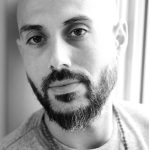The Via Negativa & the Winter Solstice
Contemplative Column
by Staff Writer Theodore Richards
Featured in Vol 3. Issue 4 | Winter 2014 | Visit our Shop for the full print or e-editions»
Photos in Feature by Derrick Caldwell
I write having just returned from an autumn retreat at Mother’s Trust Ashram in Michigan. Most of my organization (The Chicago Wisdom Project) was there—youth and elders; staff, students and board members—as was my own family. This retreat was a beginning for us, one of many that will happen there, at the ashram, and on the land next to it where we, along with our partners, are creating The Camp of the New Rising Sun. This, our newest project, is the fulfillment of a long-held dream. We envision it as “a unique cultural hub for Chicago, the Midwest and beyond for various movements and groups to engage in the process of re-imagining our relationship to one another and the planet. Central to this work is that, in our re-imagining of education, we engage each person as a whole person, and inspire them to tell their story so that others may learn from it—to become creators rather than mere consumers of culture.”
Our retreats serve many purposes, many of them having to do with words. But it occurs to me that it simply would not be a retreat without silence: The moments in between the talking give the words their power, moments in which, for example, a child who never sees the stars can sit under the firmament quietly and watch the Milky Way. Indeed, the stars, like other light, are viewable because of the depth of the darkness they are surrounded by. The light pollution of our cities parallels the noise pollution, the pollution of so many distractions.
This is not to say that words have no value. Rather, it is to suggest that the words only have meaning when accompanied by, when balanced by, silence. These retreats—and the rites of passage that often happen on them—give deeper meaning to our lives in the city, our lives spent among words, because they remain apart from our quotidian concerns.
Our retreat cycle is seasonal. The autumn retreat celebrated the harvest and transformation of the forest into winter, culminating with the darkness of the solstice. The winter season, celebrated at the solstice, is the time of the via negativa.
The solstice, whether expressed through Christmas or pagan ritual, is the season of light—and it is so because it is, paradoxically, the season of darkness:
In a dark, quiet corner
Amid the blackness of the season of light
Lonesome in a crowd of millions
Sipping hopeful wine, in a hopeless time.
I wonder how many more dreams will die
Before we dance the dance of resurrection.
I know now, how chaotic Palestine must have been
On that dark, holy night, many years ago.
Christmas, for those of us coming out of European, Christian culture, has so little to do with Jesus, or Palestine. In Chicago, where I live, as in New York where I wrote the above poem (“Christmas in New York”, 2004), Christmas is about the darkness. We can run from it, or we can celebrate it, just as we can choose to run from the darkness in our selves, or embrace it.
The Via Negativa
Matthew Fox, in his seminal work, Original Blessing, describes the via negativa as the path of silence, emptiness, suffering and darkness. It is the path that recognizes that anything we might say about the divine would be inadequate—only silence can suffice. Perhaps more than anything, Fox’s great gift to Western theology was to reclaim the via negativa—the repression of the darkness has become deeply entrenched in Modernity. We have managed to turn everything not associated with good, bright and happy feelings into something evil. Throughout history, when dualistic monotheism encountered indigenous peoples, various gods and goddess were recast as demonic. This was especially true of The Trickster, who represented the importance of breaking taboos and crossing boundaries. The nuance that our polytheistic brothers and sisters possess—and their ability to see the value in the work of the Trickster—is something we could all learn from. Even the New Age Movement tends to avoid the dark. In Christian pulpits and in New Age bookstores alike, we chase after the light and “positive” thinking.
Of course, the via negativa teaches us that we need the darkness, the chaotic and wild spaces beyond our understanding, the spaces often found in our deepest selves. Karl Jung, for whom the unconscious was the source of our creativity, understood this. When we avoid the dark places, they do not go away; we simply repress them.
In the Vedantic tradition, it is that notion of “neti, neti”—“not this, not that”—that expresses the ineffable nature of divinity. The divine is so vast, so multifaceted, that any words we choose to use are insufficient. Of course, words are used in that tradition as in others. But we need such reminders. For the problem is not the use of words to attempt to describe the ineffable; rather, the problem arises when we begin to take our words literally, when we believe that the words themselves can express the totality of divinity. In Islam, for example, it is considered a sin both to deny the fullness of the divine by denying God’s presence in all things (tawhid); it is also a sin to conflate any one thing with divinity (shirk).
Silence and emptiness is the essence of many Buddhist traditions as well. Zen practice emphasizes simply sitting and quieting the mind. In Tibetan Buddhism, the emphasis on shunyata, or emptiness, is paramount. It should be noted that our essential emptiness does not mean that we don’t exist; rather, it means that our existence is inextricable from everyone and everything. We are so deeply interconnected that there is no essential thing at our core. But this is a pregnant emptiness, not a barren one, an emptiness that can bring forth unlimited possibilities, dreams and imaginings.
Contemplative Education
I cannot help but think as much of my own children—and of my self—when I envision the future of this land and the work we have set out to do there. It is work that is most notable for what we are not doing—the via negativa at work again. We want to keep the land sacred, not plow it or pave it. I despair when I think of the lack of opportunities our children have to be in wild spaces; of the lack of quiet in our world; of the lack of true freedom—not the false, consumerist freedom we’ve been sold—to roam freely; and of the lack of unmediated, uninterrupted time in nature for our children. This absence does violence to both body and soul. We need for our bodies and minds to wander. The Camp of the New Rising Sun is many things, but perhaps its most radical aspect is that it is a place that allows for all the senses to be employed, a place of three dimensions, not merely two. The missing dimension in our screen-saturated lives, of course, is depth.
This loss is felt even more profoundly by the children and young adults who come to the space. Our youth spend so much time in front of screens and in sterile spaces. There is always a phone buzzing, beeping, ringing, with distractions away from our deepest selves.
Mother’s Trust is the perfect partner for this deepening and silencing process to unfold because it is a truly interfaith space. The via negativa—indeed, all paths in this mystical system—is expressed in various religious traditions of the world. Coming out of the profoundly interfaith philosophies of the Ramakrishna/Vivekananda lineage, the ashram demonstrates that authentic mysticism—especially in today’s pluralistic world—tends toward interfaith.
Contemplative education is one aspect of what I would call wisdom- or holistic-education. In a perfect world—or at least in a world in which we can have an honest conversation about the nature of authentic education—we might simply call it “education”. As in other aspects of being a human being, the opportunity to reflect, to simply sit in silence, is fundamental to the educational process. Getting the information is only a small aspect of learning; engaging, in silence, our deepest selves is part of what allows that information to take on meaning.
True education and true spirituality must address the whole person, and this means a recognition that the human being inhabits a whole cosmos. We participate in the falling leaves, the barren dark days of winter, the creativity of spring and the celebration of summer. The silence and darkness of the solstice teaches us that it is balance—the yin and the yang—we need, not to tame the wild or to repress it in our selves. Not to make all the dark places light or the quiet times filled with noise. We need to find peace with the fact that our lives involve suffering—indeed, so much harm has been done by trying to overcome this truth.
 Theodore Richards is a novelist, philosopher, and educator, and is the director and founder of The Chicago Wisdom Project. He is the author of several books, most recently the novel The Conversions, and the recipient of numerous literary awards. He lives on the south side of Chicago with his wife and daughters. Visit www.theodorerichards.com
Theodore Richards is a novelist, philosopher, and educator, and is the director and founder of The Chicago Wisdom Project. He is the author of several books, most recently the novel The Conversions, and the recipient of numerous literary awards. He lives on the south side of Chicago with his wife and daughters. Visit www.theodorerichards.com

